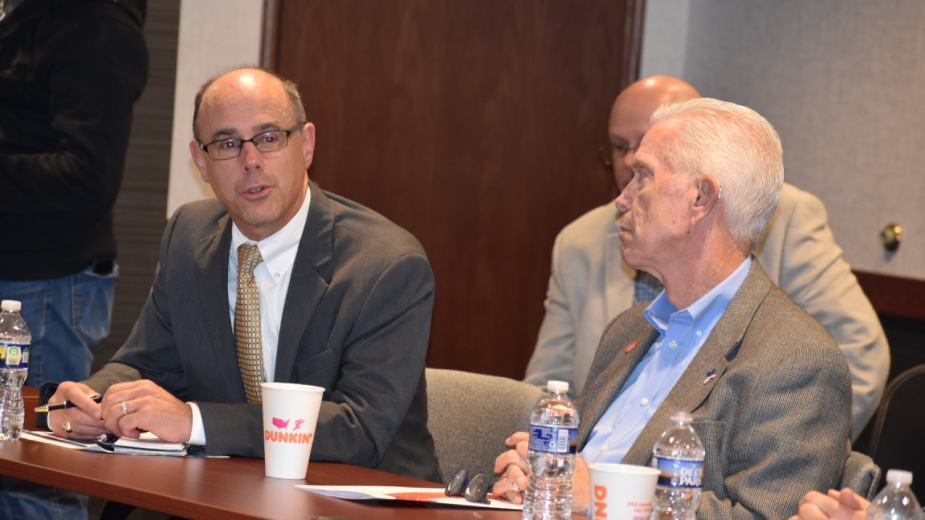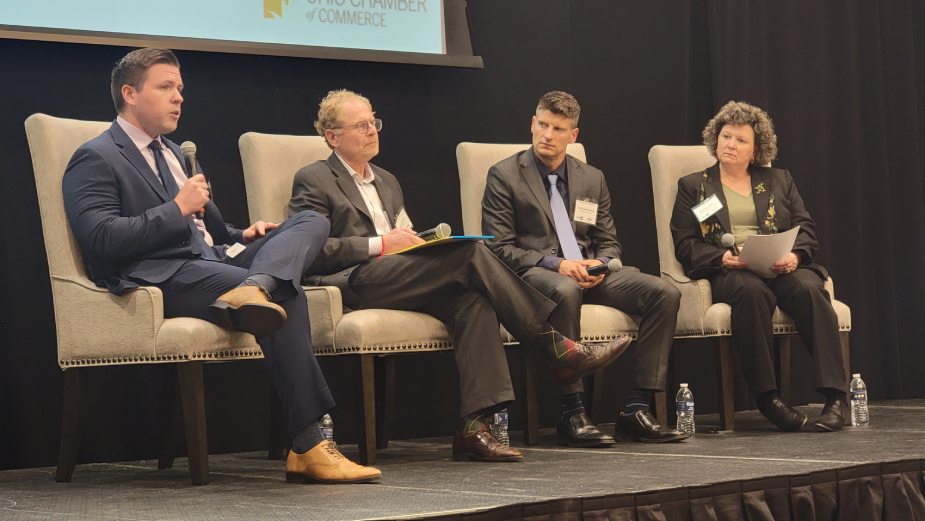Leaders Discuss Local Opportunities, Challenges
YOUNGSTOWN, Ohio – Workforce development and available land were among the issues discussed by state and local officials and business leaders during a roundtable Tuesday morning.
The estimated 40 participants in the roundtable included U.S. Rep. Bill Johnson, JobsOhio CEO J.P. Nauseef, Team NEO CEO Bill Koehler and Youngstown Mayor Jamael Tito Brown.
Also among those participating were businessmen Chuck George, CEO of Hapco Inc.; Mark Lamoncha, president and CEO of Humtown Products; and J.J. Cafaro of the Cafaro Co., along with representatives of Youngstown State University, Youngstown/Warren Regional Chamber, Western Reserve Port Authority, Eastgate Regional Council of Governments and Valley Partners.
Closed to media outlets until the end of the event, the roundtable focused on “challenges and issues facing the Mahoning Valley,” according to a media advisory from Johnson’s office. The roundtable, held at Eastgate’s offices downtown, was one of several stops in the region the congressman and JobsOhio officials had planned for Tuesday.
“As we start to take advantage of the generational opportunity that’s in front of us,” with reshoring, and people and businesses deciding to leave the East and West coasts, “Ohio is in what appears to be a wonderful position to capitalize on the opportunity, not just with what we’ve seen in the last year and 24, 36 months, but what’s in the pipeline and where the opportunities exist,” Nauseef said.
Local opportunities include the growing investment in the vehicle electrification sector, more popularly known regionally as Voltage Valley.
Johnson touted the multiple opportunities in Ohio, including the $20 billion Intel manufacturing plant complex under construction near Columbus and anticipated 150 new companies that will be part of the plant’s potential supply chain.
“People go to where the opportunities exist,” Johnson, R-6 Ohio, said following the roundtable. “What we’re trying to accomplish here is to create an atmosphere of opportunity.”
Topics included ongoing economic development efforts in the region, local challenges and opportunities, and the need to convene a group of stakeholders such as the one assembled for the roundtable, to develop “a common strategy with common objectives and goals in mind,” Nauseef said.
“The overarching theme was we want to work together,” he said. Having such a diverse group come together to discuss economic development is “the biggest indicator of future success,” he added.
Participants discussed the “generational opportunity we have to grow the economy,” sustainable competitive advantages the Valley economy has over other communities and the willingness to face local challenges, said Guy Coviello, president and CEO of the Regional Chamber.
Workforce development is the region’s largest challenge, he continued. Efforts to capitalize on opportunities will “fall short if we don’t reverse the population trends” in the region.
“Although workforce [development] is a universal challenge, it is worse here I think than pretty much any other community because of our population decline. If we can’t rebuild the population, we can never grow an adequate workforce,” he said.
“We’ve got to get back to basics and we’ve got to build those connections with people outside of our region and create a recruiting function for the state in a different way that’s ever been imagined,” said Jennifer Oddo, executive director of YSU’s division of workforce education and innovation, said.
Oddo pointed to the “huge” educational assets the Valley has, noting that people “lean on education” during times of recession, although that dynamic has seen a shift to short-term training programs.
“We’re doing upskilling. That’s where the investment is going to go,” she said.
Efforts to attract people to the region need to be coordinated, Coviello said. The Ultium Cells plant offers opportunities to attract people from South Korea and Taiwan, but local officials are hearing there is no “cultural outreach” to attract them to the region. So they go to a community like Solon and commute, which “doesn’t do us any good,” Coviello said.
Additionally, there is the perception that the area lacks the “quality of life amenities” that would attract the technology workers that plants need.
“I would argue that we probably have half the things that we’re looking for,” just that there is “no coordinated effort” to make those workers aware of those local amenities.
Coviello also pointed to opportunities to attract the “millions of professionals” now fleeing Ukraine and Russia. “They’re not going back. There’s a great opportunity,” he said.
Additionally, he pointed to the second biggest challenge facing the region, the lack of shovel-ready sites. “We have very few sites remaining that are conducive to modern manufacturing and modern warehousing and distribution,” he said.
“We’re seeing a greater demand for our community for potential sites for growth,” affirmed Anthony Trevena, the port authority’s executive director.
The port authority has about 2,400 acres available, including the approximate 1,000-acre former Republic Steel site in Trumbull County and the former McGuffey Mall property on the city’s east side, he said. WRPA also recently received a $268,211 grant from the U.S. Economic Development Administration to study the Youngstown-Warren Regional Airport’s potential to drive regional economic growth.
“We’re really not just looking at acquiring land to put it together but its strategic purposes and what we can do with it going forward,” he said.
At the federal level, reforming the permitting process is a “big deal,” whether for infrastructure or oil and gas projects, Johnson said.
“We need the federal government to streamline and get out of the way so that these projects can get off the ground and get started,” the congressman said.
Pictured at top from left: Guy Coviello, president and CEO of the Regional Chamber, and U.S. Rep. Bill Johnson.
Copyright 2024 The Business Journal, Youngstown, Ohio.



